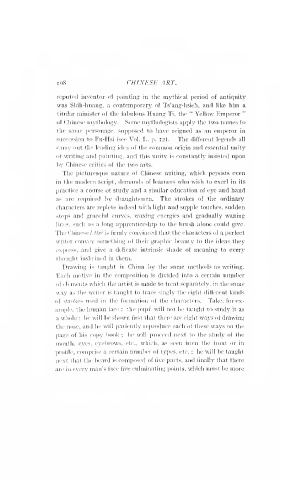Page 362 - Chinese Art, Vol II By Stephen W. Bushell
P. 362
io8 CHINESE ART.
reputed inventor of painting in the mj'thical period of antiquity
was Shih-huang, a contemporary of Ts'ang-hsieh, and like him a
"
titular minister of the fabulous Huang Ti, the " Yellow Emperor
of Chinese mythology. Some mythologists apply the two names to
the same personage, supposed to have reigned as an emperor in
succession to Fu-Hsi (see Vol. I., p. 12). The different legends all
carry out the leading idea of the common origin and essential unity
of writing and painting, and this unity is constantly insisted upon
by Chinese critics of the two arts.
The picturesque nature of Chinese writing, which persists even
in the modern script, demands of learners who wish to excel in its
practice a course of study and a similar education of eye and hand
as are required by draughtsmen. The strokes of the ordinary'
characters are replete indeed with light and supple touches, sudden
stops and graceful curves, waxing energies and gradually waning
lines, such as a long apprenticeship to the brush alone could give.
The Chinese Ictlrr is firmly convinced that the characters of a perfect
writer convey something of their graphic beauty to the ideas they
express, and give a delicate intrinsic shade of meaning to every
thought inshrined in them.
Drawing is taught in China by the same methods as writing.
Each motive in the composition is divided into a certain number
of elements which the artist is made to treat separately, in the same
way as the writer is taught to trace singly the eight different kinds
of strokes used in the formation of the characters. Take, for ex-
ample, the human face : the pupil will not be taught to study it as
a whole ; he will be shown first that there are eight ways of drawing
the nose, and he will patiently reproduce each of these ways on the
page of his copy book ; he will proceed next to the study of the
mouth, eyes, eyebrows, etc., which, as seen from the front or in
profile, comprise a certain number of types, etc. ; he will be taught
next that the beard is composed of five parts, and finally that there
are in every man's face five culminating points, which must be more

